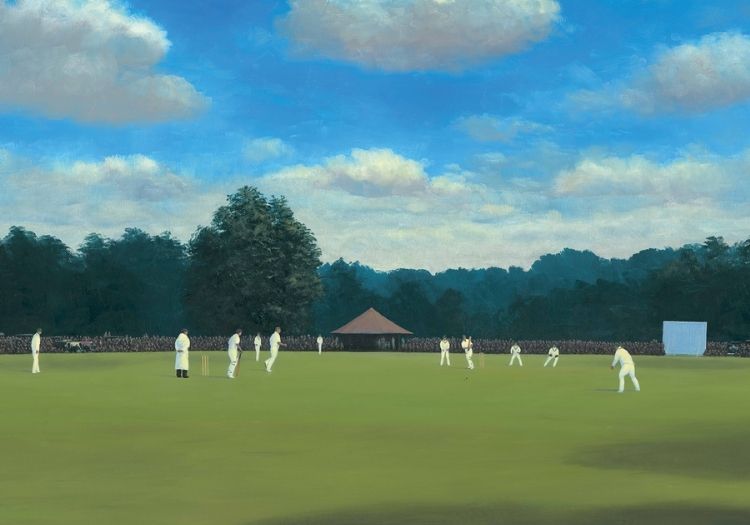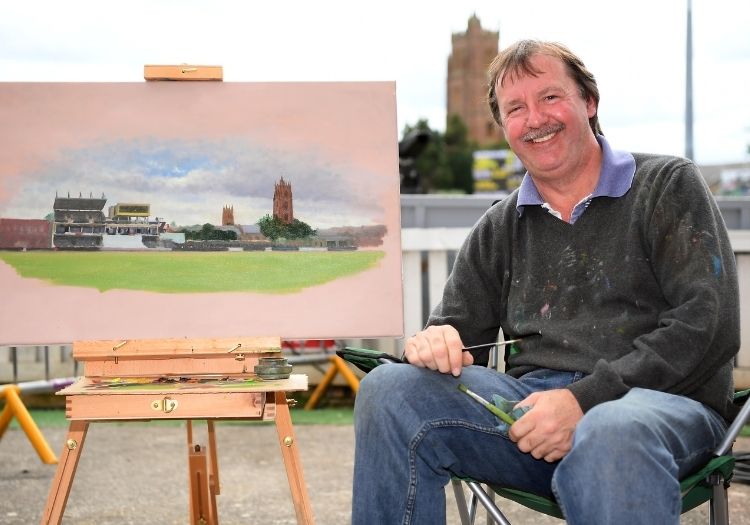
Jack Russell tells James Coyne why he painted Jack Hobbs batting in a near-forgotten 'unofficial Test' 100 years ago
Only one man has come close to scoring 200 first-class hundreds – and debate still rages about whether the exact number was 197 or 199…
Yet, for all the centuries racked up by Jack Hobbs for Surrey and England, he said he never batted better than in a somewhat obscure country-house tour match: 85 retired hurt for Lionel Robinson’s XI against the 1921 Australian tourists at Old Buckenham Hall in rural Norfolk.
“I was playing at my best form,” Hobbs told The Times years later. “I always think that I hit the real height of my abilities. Everything came off. There were some good bowlers and all my shots I kept middling.”
When Jack Russell learned of this near-forgotten ‘private Test match’ played 100 years ago this spring, the England wicketkeeper-turned-painter was inspired to recreate ‘The Master’s’ innings on canvas.
“It all came about because I was asked to paint the ground at Old Buckenham CC as it is today,” says Russell. “Then someone at the club said, ‘Do you know about the unofficial Test match that was played here against the Australians?’ I was taken aback. I had no idea.
“I did a bit more research and saw all the great names who played on both sides, and that Jack Hobbs declared that he had batted at his best.
“I gradually realised ‘I’ve just got to do this’. Not for the money or anything – though I have sold the original! And we were coming up to the 100th anniversary. Anything to do with the Ashes, I’m hooked anyway…”
Lionel Robinson, who owned the ground and financed the fixture, was one of those outlandish capitalists you read about from the era. He was born in Colombo, Ceylon (now Sri Lanka) of Australian parentage, and returned ‘home’ to make a fortune at Broken Hill and Kalgoorlie in the mining boom.
He moved to Britain to work on the London Stock Exchange, and in 1906 bought Old Buckenham Hall and its surrounding 2,000-acre estate from Prince Frederick Duleep Singh, son of the last maharajah of the Sikh Empire.
But Robinson’s brass-necked money-making and social climbing did not go down well among elements of the aristocracy. In 1977, Barry Wilson reflected in the Sunday Times that “as a country gentleman he was neither genteel, effortless not stylish. He was obstinate and aggressive and known for his abusive slanging matches with staff”. There are tales of him ramming his car into the house gates when his orders were not followed.
Installing a stud and cricket ground on his estate, with turf specially imported from Australia, was presumably part of his attempt to curry favour with the aristocracy.
Robinson befriended Archie MacLaren, himself with a chequered reputation, and employed him as his cricket manager. MacLaren and his family even lived on a house on the estate, The Warren, during one of his periods of penury.
The duo persuaded the cricket authorities to include a first-class match against Lionel Robinson’s XI as the second game of the Australians’ 1921 tour, from May 4–6.
Stephen Musk, Robinson’s biographer, concluded that in all likelihood he ‘bought’ the fixture, even if the Australian tour manager Sydney Smith’s accounts note an official payment of just £150 to the tourists; the Australians might have received at least £1,000 for fixtures from the bigger counties.
Plum Warner, editor of the new ‘weekly paper’ The Cricketer, suggested making it an official Test Trial ahead of five Ashes Tests, but Robinson wanted to choose his own XI. The side he picked was mostly of Test quality – though more amateur-orientated than a truly representative England team would have been – with the glaring makeweight being captain MacLaren, seven years since he had last played a first-class match.
Tellingly, while the nine amateurs were invited to stay in the bedrooms at Old Buckenham Hall, the two pros, Hobbs and Patsy Hendren, were obliged to bunk up elsewhere. It was so cold that Australia’s Charlie Macartney asked for more coal for the fire in his hotel room.

Jack Russell is hooked on the Ashes
The first day was marred by rain and snow, with just 15 minutes’ play possible. The home captain had been commissioned by Warner to write The Cricketer’s match report – imagine Joe Root doing the same today! – and of the next morning MacLaren wrote: “Macartney, who was in with [Herbie] Collins, stipulated that he was not out if bowled off a snowball.”
The second day was cold and gusty, but stayed dry. Close to 12,000 flocked to the ground; Robinson always allowed free admission, and laid on horse-drawn carriages and motor cars to bring spectators from nearby stations.
The swing bowlers Johnny Douglas and Clem Gibson – bowling in tandem for 80 minutes – ran through the Australians for just 136 on a docile pitch, before Hobbs and Vallance Jupp bedded in for a big second‑wicket stand.
MacLaren wrote: “No bowler made the ball buck as did [Ted] McDonald, who bowled well enough to have gone through half the side in our first hour at the wickets, had not Hobbs, as the Australian skipper pointed out to me, been at his very best.” Hobbs suffered a couple of blows to the body, but his timing and leaving was said to be top-notch.
This is the passage of play recreated in Russell’s painting, and reflects all his usual background checks when it comes to depicting past cricket matches.
“I do like to do my research, especially on the weather conditions,” says Russell. “I contacted Philip Avery and John Hammond at the BBC and they were able to pass on the precise weather and cloud formations from the day.
“It was still quite cold, which is why all the Aussies except the bowler are wearing their sweaters. Interestingly their jumpers on this tour don’t have the strips at the bottom as they do later on.
“I know from being there that the ground is slightly on a slope. I’ve made the trees not quite so high as they are now.
“And every spectator has a hat on! Even though it was ‘the Roaring Twenties’, most people had quite a sedate dress sense, with lots of pastel browns and greys. So you can’t spot any bright reds or anything.
“A friend of mine, Dr James Hull, has an incredible classic car collection, and he allowed me to photo some 1920s cars so I could capture them accurately in the crowd.
“I couldn’t find any photos of Jack Hobbs batting in the game, so I’ve gone for the push through the onside with which he brought up his hundredth hundred, two years later at Taunton.”
Back in Norfolk, Hobbs, 15 short of a century, called Jupp for a quick single and his thigh muscle, which he had aggravated in Australia over the winter, gave way again. Jupp heard it snap as Hobbs ran past then hobbled off to the pavilion. “What became of the match after,” wrote Ronald Mason, “nobody cares.” (It was a draw.)
England’s premier batsman was laid up until mid-June. He tried to come back for the third Test at Headingley, but went down with acute appendicitis, and didn’t bat in a single innings of the Ashes, as England lost the series in eight days’ playing time.
Robinson was suffering from terminal cancer in May 1921, and he would die little more than a year later, aged 55. This was the last first-class match on his field of dreams, which would endure a tortured existence.
The hall was turned into Old Buckenham Hall School, but fire destroyed the building in 1952, and the school relocated 30 miles south to Brettenham in Suffolk.
What really catches the eye in Russell’s painting is the distinctive thatched pavilion, white-clad figures huddled underneath for shelter.
Incredibly, Old Buckenham Hall School took this entire building with them to Suffolk, slat by slat, and it still stands as their 1st XI pavilion 100 years on.
This year the school are raising funds to renovate the thatched roof, and are planning to auction prints of Russell’s painting.
As for the original ground they left behind, by the late 1950s it was an overgrown campsite with a motorcycle track running around it. But twin brothers Will and Horry Panks, who were farming the adjacent field, gained access to the ground so that the village team, Old Buckenham CC, could move there. So a decayed country house ground, created in splendid isolation by an audacious Australian, was turned into a beautiful arena again.
And in 2021 cricket thrives on the spot where Jack Hobbs scaled heights of batsmanship few ever have.
Prints of the painting and the full account of how Jack Russell painted it are available on jackrussell.co.uk